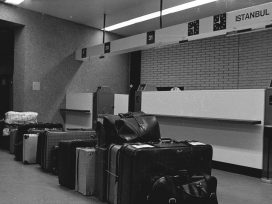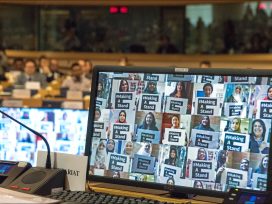It is not distance from but proximity to modern life that triggers a return to religious identity among migrant Muslims in Europe, says Nilüfer Göle. What we are witnessing today is a shift from a Muslim to an Islamist identity. The religious self for individual Muslims is being shifted from the private to the public realm.
It is puzzling to ascribe a role in European integration to religion, especially to me as a researcher of Islam, and with a Turkish background. For me, the role of religion in respect to the European Union acquires a different meaning. This is first of all because when we refer to the role of religion in European integration and to Islam in particular, we usually think of it in negative terms, namely as a hindrance to European integration. Secondly, a person with a Turkish background would be inclined to tackle this issue in a specific way.
Turkish modernists have been uncompromisingly secular since the foundation of the Turkish Republic in 1923, and they still are. In consequence, European integration or Europeanness means the final accomplishment of a secular project for those Turks who embrace European values of modernity. Therefore, from this particular historical and cultural background, it is puzzling to think of European citizenship as integration through religion. On the other hand, it is a challenge to encourage rethinking the role of religion in the construction of Europeanness, not only from the dominant perspective of Christian heritage, but also in relation to the Islamic presence.
“The role of religion in European integration” is a title that invites us to rethink the issue of religion as a kind of positive force, a positive value – Danièle Hervieu Léger called it “le travail civilisationnel”. Seen from the angle of Islamic religion, this appears to be a much more difficult task, not only because today Islam is used (and misused) as a political force of opposition for Muslim agency, but also because it is perceived by many Europeans as the different “other”, thereby necessitating containment and exclusion.
The presence of Islam through migration in European countries, but also through Turkey’s candidacy for the European Union, addresses new issues of difference and tolerance in Western democracies. Turkey as a candidate EU member state triggered a public debate in many European countries. The discussions during the Copenhagen summit (2002) illustrated well the importance of Islam in European public debate. It was perhaps on this occasion that the identity of the European Union and the meaning of Europeanness were debated for the first time, not only by politicians and technocrats, but by an involved society at large.
The question of whether European unity should be defined by a common heritage of Christian religion and Western civilization, or in reference to political values, multiculturalism, and democratic inclusiveness, divided European public opinion. It was interesting to observe that, as Turkey moved closer to Europe, apprehensions within European public opinion were made explicit with respect to Islam, and the necessity of defining and maintaining the frontiers of Europe was evoked by many politicians, intellectuals, and members of society.1
Indeed the title of Paul Scheffer’s article, “An open society needs borders”, might be seen as translating this tacit desire and fear within the Dutch context of migration. Knowing that the question of borders is not merely a question of geographic belonging, but also of cultural and civilizational differences, the ways in which governments deal with the presence of Islam in Europe becomes a crucial issue for the construction of European political values.
If we leave Islam aside for a moment and think of the role of religion in the contemporary modern world, and of whether religion can provide us with common values to define European citizenship, one conceptual problem that we face is that we can no longer define religion through its institutional representations. As Marcel Gauchet and Charles Taylor have claimed, we are observing a process of deinstitutionalization of religion today. It is not religion that has disappeared from modern life, but its institutional forms of representation.
Religion in the modern world has become a much more personal and spiritual experience. But this does not mean that it is limited to the private sphere. People can have a personal religious experience and yet belong to a collective group or to collective movements. Charles Taylor describes social disembeddedness as a condition for a different kind of social imaginary; that is, “‘horizontal’ forms of social imaginary, in which people grasp themselves and a great number of others as existing and acting simultaneously.”2 In the modern age, religious experience becomes part of “expressive individualism”, that is, it becomes important to find one’s own way against a model imposed from outside – be it from society, the previous generation, or religious authority.3 As Taylor rightly reminds us, although there is a strong individualist component to the religious experience in modern times, this will not necessarily mean that the content is individuating; on the contrary, many join powerful religious communities.4
So which religion do we refer to in relation to the European project? Very often, rather than referring to present-day religious practices and values, we refer to a prior Christian heritage.
I think the process of deinstitutionalization of religious experience is equally valid for Islam. Islam, which has traditionally been a binding force among those who belonged to a locality, to a particular confession, and to a nation-state, today becomes a reference point for an imaginary bond between those Muslims who are socially uprooted. In this respect, contemporary Islam shares some common themes with modern forms of religious experience, because it represents socially disembedded forms of religiosity and, as a consequence, becomes a matter of personal choice.
Rather than being a descendant of given religious structures, authorities, or national and confessional allegiances, the experience of Islam today works as a horizontal social imaginary bonding that connects many different Muslim actors in different contexts, acting together and simultaneously. Islamism refers to the modern production, elaboration, and diffusion of this horizontal social imaginary bonding in spite of the historical distinctions between spiritual Sufi and canonized Shariat Islam, Shia and Sunnite Islam, and conservative Saudi Arabia and revolutionary Iran.
Furthermore, the contemporary politicization of Islam engendered a displacement of the authority of the religious classes (ulema). On one hand, this meant a democratic opening of the interpretation of religious texts to the public at large, including political militants, Islamic intellectuals, and women. On the other hand, it brought about a vulgarization of religious knowledge and sources, which is used, and especially abused and taken out of context, in favour of the political ideology of Islamism. Therefore, radical Islamism does not subscribe to the traditional interpretations of religion; Islamist discourse is simplistic, anachronistic, and cut off from its referential context of the Koran.
Islamism operates as a sort of ideological amalgam between different schools of Islam, national cultures, and popular customs. Laypersons who speak the language of Islam without the institutional authority of religious schools and knowledge find legitimacy in their activism. Activism and terrorism provide, or rather impose, a new source of legitimacy for the Islamic idiom. Who will decide what is licit and illicit in Islam? Who has authority over the interpretation of religious texts? Who can give a “fatwa” and declare a “jihad”? These questions become very problematic as Islam becomes de-traditionalized in the hands of Islamism in particular, and in the face of the modern secular world in general.
Islam today is constructed, reinterpreted, and carried into public life through political agency and cultural movements, not through religious institutions. At the same time, the presence of Islam in public life and in the shaping of social imagery and daily practices of Muslims is increasing. We are therefore observing both personal and collective appropriations of Islam. Even though this does not take place on an institutional, purely political, or revolutionary level, we can observe a growing public visibility of Islam and its claims for public visibility in Europe and elsewhere.
Islam is moving into new life spaces, but we still have a tendency to think about it as belonging to a locality and without any claim to universalism. It is sufficient to trace the trajectory of contemporary Muslim actors empirically to see their move from rural to urban cities, from the margins to the centre of politics, and, of course, through migrations, to the core of big Western cities. We often speak of this process or move as something negative, emphasizing the fact that these people are socially uprooted, which leads to alienation and terrorism. However, as we know from classical sociological literature, social mobility is also a precondition for the predisposition to a modern personality.
We now need to consider how this can be linked to religion. Disembeddedness and social mobility of Muslim actors means they experience a sense of distancing from, if not a break with, their social origins and local towns. This is true for migrant Muslims in Europe, but also for recently urbanized social groups in Muslim countries. Consequently, their religious experience is of a new kind; it is not directly handed over by community, religious, or state institutions. It is a kind of social imaginary, through which they reconstruct their sense of belonging to Islam. Their Islam is not linked to a territory or to a tradition, like Shia Islam or Sunni Islam. It is, rather, a kind of syncretic Islam getting into action.
I am trying to argue therefore that being a Muslim and being an Islamist are not the same thing. What we are witnessing now is a shift from a Muslim identity to an Islamist identity. This new phenomena connected with Islamism cannot be derived from confessional or national schools of Islam. What we observe in contemporary forms of political Islam, rather, is an affirmative reconstruction of identity, a collective social imaginary. The presentation of a religious self which is put forward, is being carried from the private to the public realm, albeit personally and collectively, and in a form of conflictual engagement with the Western and secular values of modernity.
Those Muslims who embrace a more radical form of affirming their religious and cultural identity, however, are those who leave their local origins behind and enter into new public, urban, European life experiences. There is a sociological paradox behind the phenomenon of Islamism. It is not the distance from but, on the contrary, the familiarity with and proximity to modern forms of life, education, and politics that trigger a return to religious identity and its political expressions.
Radicalism is mostly a feature of those groups who by their experience of mobility and displacement have become acquainted with secular and Western ways of political thinking and urban living. Modern techniques of self-presentation and regimes of communication are acquired in public spaces such as schools, associative life, urban habitat, and media. Yet Muslim actors are not in conformity with the national and secular rules of public spaces; they perform and openly claim their religious identity and habits in public.
Islam provides a framework for the orientation of this identity, a framework in Charles Taylor’s sense, that incorporates a set of crucial qualitative distinctions that provide a sense of good and higher forms of life.5 Islam is used as a source of orientation and distinction to represent and to achieve a higher form of life. But for that purpose, the radicals would claim, religion needs to be liberated from its traditionally subservient, passive, and docile posture in the face of modern power. Religion provides an autonomous and alternative space for the collective self-definition of Muslims in their critical encounter with modernity. It provides a cognitive framework for the personal self-fashioning and collective orientation of the movement. The politicization of religion and a personalized religiosity go hand in hand, a process made possible by the weakening of religious ties to their traditional context, hierarchical authority, and canonical interpretations.
The visibility of religious symbols and performances informs the public of the radical transformation that is taking place, from the concealment of Muslimness and its cultural attributes to collective and public disclosures of Islam. By wearing a veil and a beard, by claiming their right to prayer sites and working hours, specific food regimes, etc., they become overtly identifiable as Muslims and publicly assertive. They also convey a sense that they are more zealous and meticulous in their religious observance than those who confine their religiosity to the private sphere.
Veiling is usually taken as a sign of the debasement of women’s identity, as a sign of their inferiority to men. Those Muslim women who are no longer confined to a traditional role and to an enclosed space are now readopting this sign of passivity and seclusion within interior domestic spaces. They are crossing the frontiers of that interior space and gaining access to higher education, urban life, and public agency.
Veiling thus becomes both a personal and collective expression of Islamic religiosity. It is personally carried as a bodily sign, but also imagined as a source of collective empowerment and a horizontal bond between those who distinguish themselves as Muslims, and, more precisely, as Islamists. They turn veiling, an attribute of potential public discredit, into a subaltern advantage. As a result, they are changing the meaning of veiling as they carry it into new modern spaces. From a symbol of stigmatization (as a sign of backwardness and gender inequality), it is transformed into a positive identity affirmation (such as “black is beautiful”), bestowing Muslimness with a higher sense of self. Through a collective affirmation of Islamic identity, a historical sense of loss of dignity and humiliation is turned into a search for distinction, prestige, and power (best exemplified by the Iranian revolution).
To sum up, the practice of veiling is not in continuity with prevailing Muslim cultural habits and pre-established religious conventions. On one hand, it is not in conformity with liberal gender presentations, but on the other hand, it also transgresses Muslim communitarian values of morality. The case of young Muslim women in Europe illustrates well the ongoing transformations of the meanings of the headscarf. Young migrant girls who adopt the Islamic headscarf in French and German schools are closer in many respects (namely youth culture, fashion consciousness, and language) to their classmates than to their first-generation, homebound, uneducated mothers. The young girls who adopt, improvise, and negotiate the headscarf in the public sphere are at the same time, albeit unintentionally, altering the symbol of the headscarf and images of Muslim women.
What we therefore observe is that these new European Muslims have a double belonging, a double cultural capital. On one hand, they define themselves through their religiosity, but they have also learned techniques of self-representation in public spaces and gained universal, secular knowledge. Because they have a double cultural capital, they can circulate between different activities and spaces such as home, class, youth associations, and urban leisure space.
Thus far, I have briefly depicted the ways in which Islam is becoming an identity reference for new Muslim figures who are bestowed with a double cultural capital, namely secular and religious. Secondly, I have tried to shift the perspective of our analysis from convictions and values of persons and groups to a notion of space, common space, and public space. The Islamic presence in public therefore challenges the strict separation between private religion and public secularism. Religion is carried into public life, a process through which the profane and sacred realms are intermingled. The regulations of public space become controversial; not only schools, universities, workplaces, and parliament, but also public gardens, cemeteries, and beaches, undergo a similar influence when Muslims invest in and make claims for religious rules in conformity with Islamic religion.
What we face today as a political problem is the issue of the public visibility of religion. The public sphere is undergoing changes. We therefore cannot speak of the public sphere as a pre-established, immutable arena. The inclusion of new social groups necessitates a redefinition of its frontiers, and its normative values. Newcomers reveal the limits of the public sphere as constituted and imagined by the society and its legislators at a given time. The “headscarf debate” in France, for instance, provoked a larger public debate on the school system as well as on French secularism, namely “laicité”, considered to be a French exception.
We are reminded of the historical heritage of laicité and the principle of neutrality in the public school system by the protagonists who argued for banning all religious signs. However, the government’s project of setting up a new French Council for the Muslim Religion has already produced a change in relations between the French State and Islam.6 On one hand, an Islamic religious organization means public recognition of the Islamic presence in France, and therefore political acknowledgement of Islam as independent from the problem of immigration. On the other hand, it also means a space for religion in public, as well as a space created by means of State initiative. Secular conceptions and frontiers of the French public sphere are a subject of public controversy and are undergoing a radical change in respect to the problems of integration of Muslim immigrants. Yet the terms of the debate were discussed at a national level and with an emphasis on French exceptionalism, rather than with a future-oriented European perspective.
With reference to Europe, however, the question is: Are we going to handle this issue through a kind of “didactic democracy”, one you teach through legislation – a kind of authoritarian intervention, where, for example, you forbid the veil? Ironically this reminds me of Turkish secularism that was historically adopted from French laicité. Today, Turkish forms of the state control of religion turn out to be a model of reference. Or do we have any other way of thinking about democracy as a way of inventing new forms of commonness? The definition of a new commonness requires a reconsideration of the issue of public space on a European scale.
Until now, this public space has been defined by the nation-state and by institutionally defined religions. Therefore, borders that Europe is now trying to transgress were imposed by state institutions and religious institutions. We still take this public space for granted, however. Can we open it up? Redefine this publicness, this commonness as European public space? Not only by means of legislation, but also as a common values space to be shared and imagined. Conceiving a European public space and a European civility could help us to go beyond the national scale and the confrontational definitions of civilization and focus on daily life experiences and interactions. Why not imagine European public space as an ethical and physical frame that enables us to develop a common civility drawn from liberal pluralism as well as a plurality of religious experiences?
Cf. the articles published in the French, German, and Turkish press during the Copenhagen summit; see also the Internet site www.ataturquie.asso.fr .
Charles Taylor, Varieties of Religion Today, Cambridge: Harvard University Press, 2002, 84.
Ibid.
Ibid. 112.
Charles Taylor, Sources of the Self. The Making of the Modern Identity, Cambridge: Harvard University Press, 1989.
The Minister of Interior, Nicolas Sarkozy, succeeded in persuading rival Muslim organizations to create a New French Council for the Muslim Religion whose members were first elected on 13 April 2003. The organization of the Jewish consistory which was set up under Napoleon in 1806 is given as an example of the French state regulating its relations with other major religions. The Council represents the first ever unified body authorized to speak on behalf of the five million French Muslims. The aim is to develop a homegrown and liberal Islam.
Published 3 May 2007
Original in English
First published by Krzysztof Michalski (ed.), Conditions of European Solidarity, vol. II: Religion in the New Europe, Central European University Press 2006.
Contributed by Transit © Nilüfer Göle / Institute for Human Sciences / Eurozine
PDF/PRINTPublished in
In collaboration with
Newsletter
Subscribe to know what’s worth thinking about.
Related Articles

Germany was quick to claim the German-Turkish vaccine developers of Pfizer/BioNTech as proof of its open society. But their success is more an exception than a rule. Rather than congratulate itself, Germany needs to confront how it abandoned the migrants it once invited.

Kulturkampf
Vagant 2–3/2020
‘Vagant’ explores intellectual landscapes of the New Right: including Thilo Sarrazin, Monika Maron and Michel Onfray. Also, a conversation with Danish novelist Olga Ravn Ravn about dominant attitudes to motherhood.




